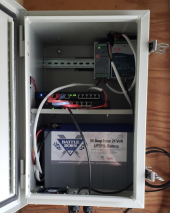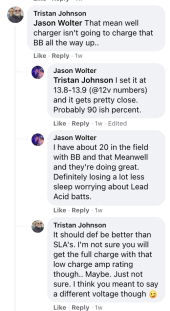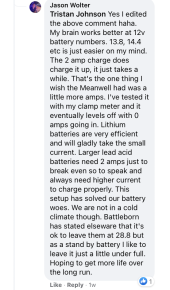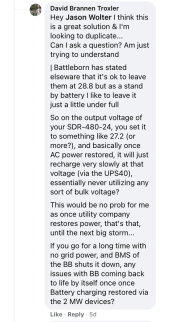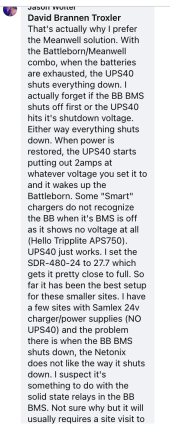zaps
New Member
- Joined
- Jul 4, 2020
- Messages
- 20
I've been thinking about making an online UPS with a LiFePo4 battery. "Online" means the load is running on the inverter even when mains power is available.
To show the general idea, there's a diagram of one below based on a lead-acid battery. The 120VAC mains power on the left drives the battery charger. The battery charger powers the inverter while float charging the battery. For the lead-acid battery, the float voltage in this example is set to 13.8 VDC. The load is running off the inverter, and if mains power is lost, the battery keeps supplying power and the load keeps working, until the battery dies. If the UPS needs to go offline for some reason, the bypass switch allows the load to run directly on commercial power.
The tricky part of using LiFePO4 here seems to be picking a "Goldilocks" float voltage that isn't so high that it harms the battery, yet isn't so low that the battery has low capacity. It's been suggested that 13.0V works, but the tables of voltage vs. capacity aren't encouraging, indicating about 30% capacity.
So I'm wondering:

To show the general idea, there's a diagram of one below based on a lead-acid battery. The 120VAC mains power on the left drives the battery charger. The battery charger powers the inverter while float charging the battery. For the lead-acid battery, the float voltage in this example is set to 13.8 VDC. The load is running off the inverter, and if mains power is lost, the battery keeps supplying power and the load keeps working, until the battery dies. If the UPS needs to go offline for some reason, the bypass switch allows the load to run directly on commercial power.
The tricky part of using LiFePO4 here seems to be picking a "Goldilocks" float voltage that isn't so high that it harms the battery, yet isn't so low that the battery has low capacity. It's been suggested that 13.0V works, but the tables of voltage vs. capacity aren't encouraging, indicating about 30% capacity.
So I'm wondering:
- If I used 13.0V as the float voltage for a LiFePo4-based UPS, what percentage of capacity should I expect that battery to have?
- Is lead acid actually better than LiFePo4 for an online UPS?
- What am I missing?






